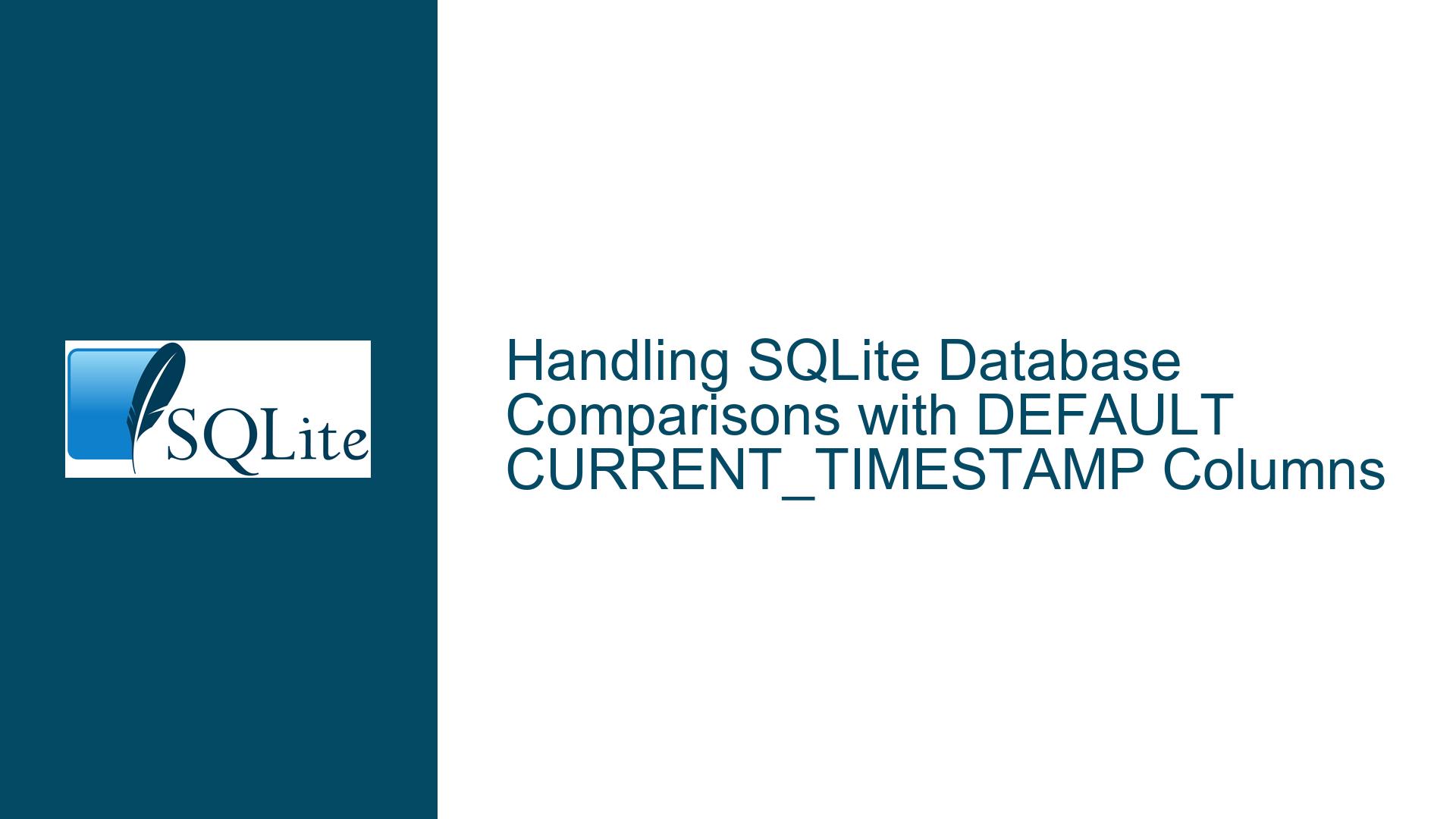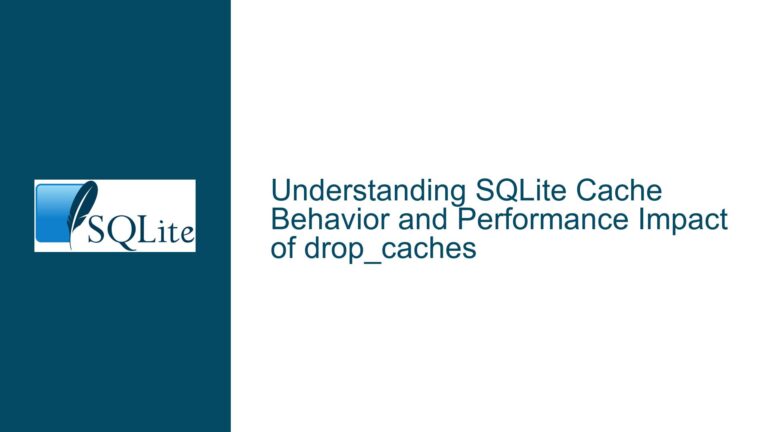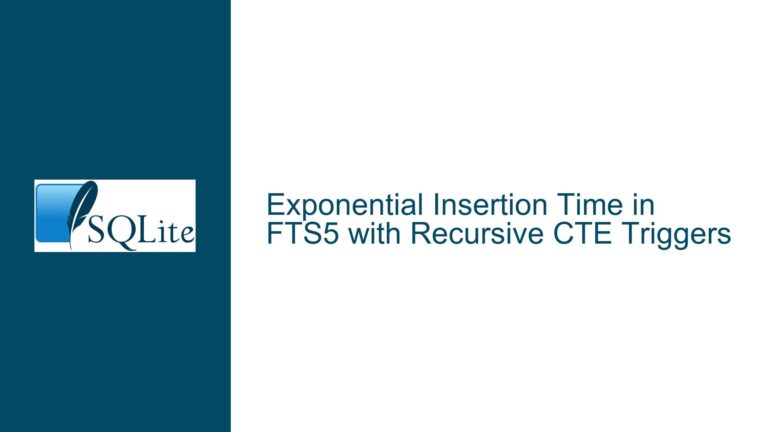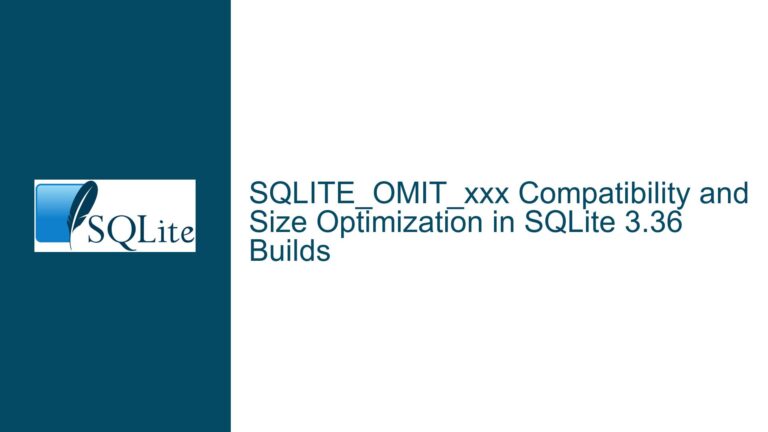Handling SQLite Database Comparisons with DEFAULT CURRENT_TIMESTAMP Columns
SQLite Database Comparisons Affected by DEFAULT CURRENT_TIMESTAMP Columns
When working with SQLite databases, a common practice is to use columns with default values such as DEFAULT CURRENT_TIMESTAMP to automatically record the time when a row is inserted. This is particularly useful for columns like created or last_modified, which track the creation or modification time of records. However, this practice introduces a significant challenge when comparing two databases that are expected to be identical in content. The DEFAULT CURRENT_TIMESTAMP columns will inherently differ between the databases because the timestamps are generated at the time of insertion, which will never be the same across different databases or even different runs of the same import process.
This issue becomes particularly problematic when using tools like sqldiff, which is designed to compare two SQLite databases and output the SQL statements needed to transform one database into the other. The presence of DEFAULT CURRENT_TIMESTAMP columns can lead to a large number of false positives in the comparison results, making it difficult to determine whether the databases are truly identical in terms of their meaningful data. For instance, if two databases are populated with the same data but at different times, the created columns will differ, causing sqldiff to report these differences even though the rest of the data is identical.
The core of the problem lies in the fact that sqldiff does not inherently know which columns are meant to be ignored during the comparison. By default, it compares all columns in all tables, which is not always desirable, especially when dealing with columns that are expected to differ, such as those with DEFAULT CURRENT_TIMESTAMP. This can lead to unnecessary noise in the comparison results, making it harder to identify genuine discrepancies between the databases.
Interrupted Write Operations Leading to Index Corruption
The issue of DEFAULT CURRENT_TIMESTAMP columns affecting database comparisons is not the only challenge that can arise when working with SQLite. Another common problem is database corruption, particularly when write operations are interrupted, such as during a power failure. SQLite is designed to be a robust and reliable database engine, but it is not immune to corruption if write operations are not completed properly. When a write operation is interrupted, it can lead to inconsistencies in the database file, including index corruption, which can render the database unusable.
Index corruption occurs when the data structures that SQLite uses to quickly locate rows in a table become inconsistent with the actual data stored in the database. This can happen if a write operation that updates an index is interrupted before it can complete, leaving the index in an inconsistent state. When this happens, queries that rely on the corrupted index may return incorrect results, or the database may fail to open altogether.
The risk of index corruption is particularly high when using DEFAULT CURRENT_TIMESTAMP columns because these columns are often updated automatically as part of insert operations. If an insert operation is interrupted, it can leave the database in an inconsistent state, with the created column containing a timestamp that does not match the actual time the row was inserted. This inconsistency can propagate to other parts of the database, leading to further corruption.
To mitigate the risk of index corruption, it is important to ensure that write operations are completed properly. This can be achieved by using SQLite’s journaling modes, such as WAL (Write-Ahead Logging), which provide additional safeguards against corruption. However, even with these safeguards in place, it is still possible for corruption to occur if write operations are interrupted. In such cases, it may be necessary to repair the database using tools like sqlite3_analyzer or by restoring from a backup.
Implementing PRAGMA journal_mode and Database Backup Strategies
To address the challenges posed by DEFAULT CURRENT_TIMESTAMP columns and the risk of index corruption, it is essential to implement robust strategies for managing SQLite databases. One such strategy is to use SQLite’s PRAGMA journal_mode to control how changes to the database are recorded. The journal_mode pragma determines whether SQLite uses a rollback journal or a write-ahead log (WAL) to track changes to the database. Each mode has its advantages and disadvantages, and the choice of mode can have a significant impact on the performance and reliability of the database.
The rollback journal is the default journaling mode in SQLite. When a transaction is started, SQLite creates a rollback journal that records the original state of the database before any changes are made. If the transaction is interrupted, SQLite can use the rollback journal to undo the changes and restore the database to its original state. This provides a high level of protection against corruption, but it can also introduce performance overhead, particularly for large transactions.
The WAL mode, on the other hand, uses a write-ahead log to record changes to the database. Instead of writing changes directly to the database file, SQLite writes them to a separate WAL file. This allows multiple readers to access the database simultaneously while a single writer makes changes. The WAL mode can provide better performance than the rollback journal, particularly for databases with a high level of concurrent access. However, it also requires more careful management of the WAL file, as it can grow large over time if not properly maintained.
In addition to choosing the appropriate journaling mode, it is also important to implement a robust backup strategy for SQLite databases. Regular backups can help protect against data loss in the event of corruption or other issues. SQLite provides several tools for creating backups, including the sqlite3 command-line tool and the SQLite Backup API. These tools allow you to create a backup of the entire database or individual tables, which can be restored in the event of a failure.
When dealing with DEFAULT CURRENT_TIMESTAMP columns, it is also important to consider how these columns are used in the context of database comparisons. As discussed earlier, the presence of these columns can lead to false positives in the results of tools like sqldiff. To address this issue, it is possible to modify the behavior of sqldiff to ignore specific columns during the comparison. This can be achieved by adding a --skipcolumn option to sqldiff, which allows you to specify columns that should be ignored. This option can be particularly useful when comparing databases that contain DEFAULT CURRENT_TIMESTAMP columns, as it allows you to focus on the meaningful differences between the databases without being distracted by irrelevant timestamp differences.
In conclusion, managing SQLite databases requires a combination of careful planning, robust strategies, and the use of appropriate tools. By understanding the challenges posed by DEFAULT CURRENT_TIMESTAMP columns and the risk of index corruption, and by implementing strategies such as PRAGMA journal_mode and regular backups, you can ensure that your SQLite databases remain reliable and performant. Additionally, by customizing tools like sqldiff to ignore specific columns, you can make database comparisons more meaningful and less prone to false positives.






